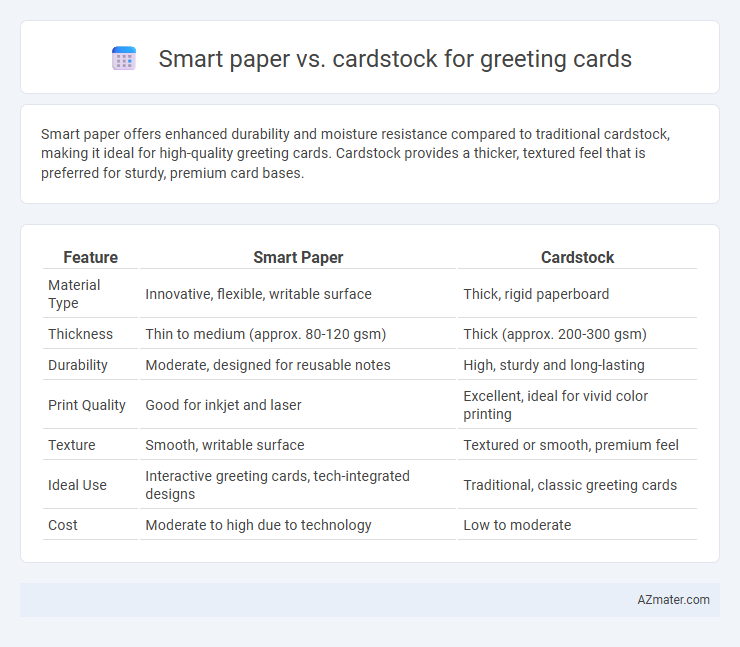Smart paper offers enhanced durability and moisture resistance compared to traditional cardstock, making it ideal for high-quality greeting cards. Cardstock provides a thicker, textured feel that is preferred for sturdy, premium card bases.
Table of Comparison
| Feature | Smart Paper | Cardstock |
|---|---|---|
| Material Type | Innovative, flexible, writable surface | Thick, rigid paperboard |
| Thickness | Thin to medium (approx. 80-120 gsm) | Thick (approx. 200-300 gsm) |
| Durability | Moderate, designed for reusable notes | High, sturdy and long-lasting |
| Print Quality | Good for inkjet and laser | Excellent, ideal for vivid color printing |
| Texture | Smooth, writable surface | Textured or smooth, premium feel |
| Ideal Use | Interactive greeting cards, tech-integrated designs | Traditional, classic greeting cards |
| Cost | Moderate to high due to technology | Low to moderate |
Introduction to Smart Paper and Cardstock
Smart paper is a technologically enhanced material embedded with sensors or conductive inks, enabling interactive features and digital connectivity in greeting cards. Cardstock, a thick and durable paper stock typically ranging from 80 to 110 lb weight, provides a sturdy and high-quality base for traditional greeting card designs. Choosing between smart paper and cardstock depends on the desired functionality, with smart paper offering innovation and interactivity, while cardstock ensures classic durability and elegance.
What is Smart Paper?
Smart paper is a type of advanced material engineered with embedded microcapsules or nanoparticles that react to environmental stimuli such as heat, pressure, or light, enhancing interactivity for greeting cards. Unlike traditional cardstock, smart paper can change color, reveal hidden images, or display dynamic textures, making greeting cards more engaging and personalized. This innovative technology allows for creative designs that combine tactile and visual effects, offering a unique alternative to conventional cardstock.
Understanding Cardstock: Key Features
Cardstock is a thick, durable paper that ranges from 50 to 110 lb cover weight, making it ideal for greeting cards due to its sturdiness and professional finish. Its smooth or textured surface options enhance the tactile experience and allow for a variety of printing techniques, including embossing and foil stamping. Unlike smart paper, which often contains integrated technology, cardstock provides a traditional, reliable medium that ensures longevity and quality in greeting card designs.
Comparing Thickness and Durability
Smart paper typically features a thickness ranging from 90 to 120 gsm, offering flexibility and ease of folding for greeting cards, while cardstock generally ranges from 200 to 300 gsm, providing superior sturdiness and structural integrity. The durability of cardstock surpasses smart paper, making it more resistant to bending, creasing, and wear over time, which is ideal for premium greeting cards intended to last. While smart paper is suitable for intricate printing and lightweight designs, cardstock ensures a robust feel and enhanced protection for cards subjected to frequent handling or mailing.
Print Quality: Smart Paper vs Cardstock
Smart paper offers exceptional print quality with vibrant colors and sharp details due to its smooth, coated surface that enhances ink absorption. Cardstock provides a sturdy base but may absorb ink unevenly, potentially leading to less precise images and colors compared to smart paper. Choosing smart paper ensures a professional, high-resolution finish for greeting cards that require crisp graphics and vivid hues.
Creative Flexibility for Greeting Cards
Smart paper offers unparalleled creative flexibility for greeting cards due to its smooth surface and superior paint absorption, enabling intricate designs and vibrant colors. Cardstock, while thicker and more durable, limits fine detail work but excels in providing sturdy bases for embellishments like ribbons and layered cutouts. Choosing smart paper enhances precision and color vibrancy, whereas cardstock supports tactile elements and structural creativity in greeting card projects.
Cost Effectiveness: Which is Better?
Smart paper offers significant cost savings over cardstock due to its lighter weight and lower material expenses, making it ideal for high-volume greeting card production. Cardstock, while more expensive, provides superior durability and a premium feel that can justify the higher cost for limited editions or special occasions. For businesses prioritizing budget efficiency and bulk printing, smart paper represents the more cost-effective choice, whereas cardstock is better suited for projects where quality and tactile experience are paramount.
Eco-Friendly Considerations
Smart paper offers a sustainable alternative to traditional cardstock by utilizing recycled fibers and environmentally friendly production processes, significantly reducing carbon footprint and waste. Unlike cardstock, which is often made from virgin wood pulp and requires more water and energy during manufacturing, smart paper supports circular economy principles and biodegradability. Choosing smart paper for greeting cards enhances eco-friendly practices without compromising durability or print quality, making it a responsible choice for environmentally conscious consumers.
Application and Compatibility with Cutting Machines
Smart paper offers a smooth surface ideal for detailed printing and works well with most cutting machines, including Cricut and Silhouette, ensuring clean, precise cuts for intricate greeting card designs. Cardstock, known for its sturdiness and variety of weights, provides excellent durability but may require blade adjustments or specialized settings on cutting machines to prevent tearing or incomplete cuts. Both materials are compatible with popular electronic cutters, but Smart paper excels in fine detail applications, while cardstock is preferred for robust, durable cards.
Choosing the Right Material for Greeting Cards
Smart paper offers a lightweight, flexible option with smooth texture ideal for vibrant prints and detailed designs, while cardstock provides durability and sturdiness, enhancing the card's tactile appeal and longevity. Selecting the right material depends on the desired finish and usage; cardstock is preferred for premium, long-lasting greeting cards, whereas smart paper suits budget-friendly and mass-produced cards. Considering factors like print quality, cost, and card rigidity ensures the greeting card effectively conveys its message and withstands handling.

Infographic: Smart paper vs Cardstock for Greeting card
 azmater.com
azmater.com